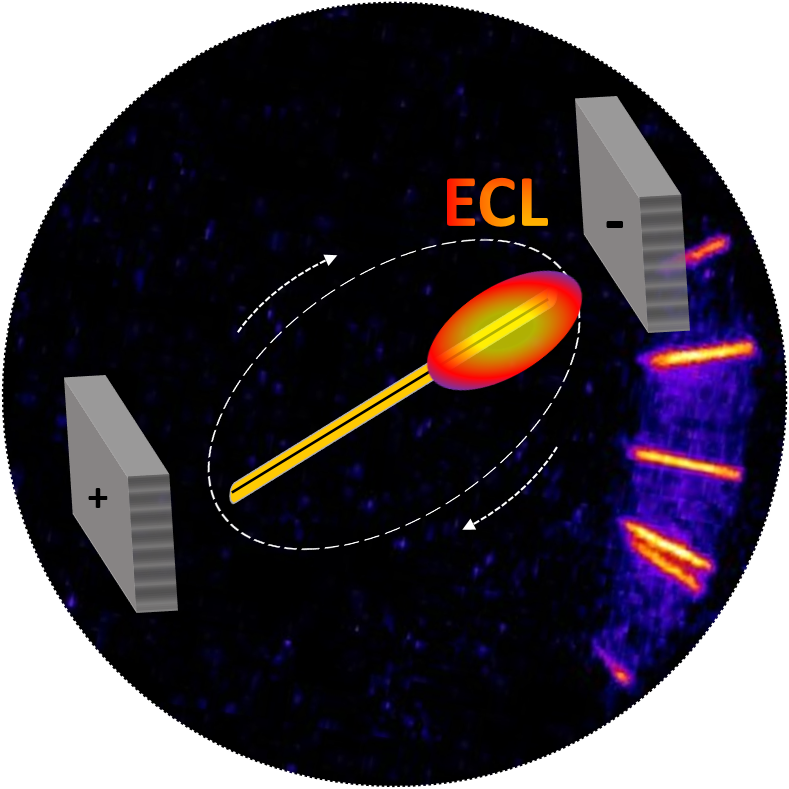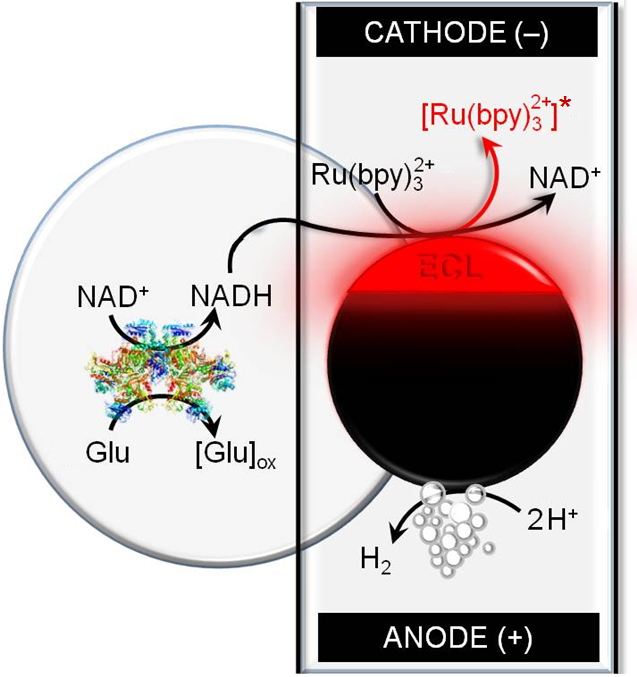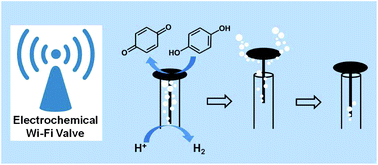| Tracking Magnetic Rotating Objects by Bipolar Electrochemiluminescence
A. Dauphin, A. Akchach, S. Voci, A. Kuhn, G. Xu, L. Bouffier, N. Sojic
J. Phys. Chem. Lett. 2019, 10, 318-5324
|
 |
|
There is a very rapid development of original systems that can be remotely controlled or addressed by playing with chemical and physical concepts. Here, we present the synergetic combination of external magnetic and electric fields to promote, in a double contactless mode, the rotational motion and the concomitant generation of light-emission at the level of a gold-coated iron wire. The latter can be moved by rotating magnetic fields. Simultaneously, an electric field induces its remote polarization, which triggers the local generation of electrochemiluminescence (ECL) by bipolar electrochemistry. During rotation, the motion is tracked by changes in ECL intensity as a function of the orientation of the conducting wire in the electric field. The ECL behavior of the rotating bipolar wire is rationalized by considering the angular dependence of the polarization. Unlike previously reported systems, the rotation induces enhanced ECL emission due to the convective flow produced by the motion. This demonstrates that ECL emission can be coupled to magnetically-controlled rotating bipolar objects. Such dual magnetically- and electrically addressable dynamic systems open exciting perspectives for integrating new functions such as imaging and sensing capabilities.
If you are not able to read the video below, click on this link
|
|
|
| Wireless powering of e-swimmers
J. Roche, S. Carrara, J. Sanchez, J. Lannelongue, G. Loget, L. Bouffier, P. Fischer, A. Kuhn
Sci. Rep. 2014, 4, 6705
|
 |
|
Miniaturized structures that can move in a controlled way in solution and integrate various functionalities are attracting considerable attention due to the potential applications in fields ranging from autonomous micromotors to roving sensors. Here we introduce a concept which allows, depending on their specific design, the controlled directional motion of objects in water, combined with electronic functionalities such as the emission of light, sensing, signal conversion, treatment and transmission. The approach is based on electric field-induced polarization, which triggers different chemical reactions at the surface of the object and thereby its propulsion. This results in a localized electric current that can power in a wireless way electronic devices in water, leading to a new class of electronic swimmers (e-swimmers).
If you are not able to read the video below, click on this link
|
Electrochemiluminescent Swimmers for Dynamic Enzymatic Sensing
M. Sentic, S. Arbault, B. Goudeau, D. Manojlovic, A. Kuhn, L. Bouffier, N. Sojic
Chem. Commun. 2014, 50, in press
|
 |
|
An electrochemiluminescent (ECL) swimmer driven by bipolar electrochemistry is reported for enzymatic glucose sensing. The chemo-mechanical motion is induced by localized hydrogen bubble generation. The concomitant oxidation of the luminophore and of the enzymatically-produced NADH leads to ECL emission with a direct glucose-dependant light intensity. We demonstrate herein the local sensing and reporting of glucose in a concentration gradient explored by the ECL swimmer. Such a dynamic sensing approach combines in a synergetic way the wireless propulsion with the enzymatic selectivity using ECL as a readout method at the level of moving objects.
If you are not able to read the video below, click on this link
|
Design of a Wireless Electrochemical Valve
Bouffier L., Kuhn A.,
Nanoscale 2013, 5, 1305-1309. |
 |
|
The control of motion of small objects is an emerging research area. Their design strongly depends on the strategy chosen to trigger the locomotion, which is typically obtained by either physical or chemical fueling. An ongoing challenge in this field is the remote control of the motion with space and time resolution. In this context, we describe in the present contribution a wireless electrochemical valve based on a chemo-mechanical feedback loop. This valve is driven by bipolar electrochemistry and works in aqueous solutions by converting reversibly an electrical input signal into periodic motion via electrogenerated hydrogen bubbles. We report the design of this very first bipolar valve, together with an analysis of the mechanism leading to the energy conversion, based on controlled production, storage and release of gas bubbles.
|
| |
|
|
Light-Emitting Electrochemical Swimmers
Sentic M., Loget G., Manojlovic D., Kuhn A., Sojic N.,
Angew. Chem. Int. Ed. 2012, 51, 11284–11288. |
 |
|
Swimmer in the dark: Propulsion of a conducting object is intrinsically coupled with light emission using bipolar electrochemistry. Asymmetric redox activity on the surface of the swimmer (black bead; see picture) causes production of gas bubbles to propel the swimmer in a glass tube with simultaneous electrochemiluminescence (ECL) emission to monitor the progress of the swimmer.
|
| |
|
|
Bipolar Electrochemistry for Cargo-lifting in Fluid Channels
Loget G., Kuhn A.,
Lab on a Chip 2012, 12, 1967-1971.
Hot Paper, Cover Article |
 |
|
We report for the first time the vertical propulsion of conducting beads in liquid filled capillaries by bipolar electrochemistry. The beads, when exposed to an external electric field, act as bipolar electrodes showing hydroquinone oxidation on one side and proton reduction on the other side. The related asymmetric bubble generation occurring at the bottom part of the beads drives their motion. The characteristic features of the propulsion can be tuned by changing parameters such as the applied electric field or the capillary shape. Using a conical capillary, we show that a Yo-Yo type motion can be induced. The quite versatile concept can then be used for cargo-lifting and is of potential interest for microfluidic applications in LOC devices.
|
Video 1:
|
Video 2:
|
Video 3:
|
|
|
Propulsion of Microobjects by Dynamic Bipolar Self-Regeneration
Loget G., Kuhn A.,
J. Am. Chem. Soc. 2010, 132, 15918-15919. |
 |
Dynamic bipolar self-regeneration is a new mechanism that allows controlled motion of metallic microobjects to be induced. This technique is based on the concept of bipolar electrochemistry, in which different redox reactions occur at the two extremities of a substrate under the influence of an external electric field. To create the motion of a metallic object, one end has to be the site of metal deposition and the other the site of metal dissolution. Propulsion of zinc macro- and microswimmers at speeds of up to 80 μm s−1 has been achieved.
|
Video 1:
|
Video 2:
|













